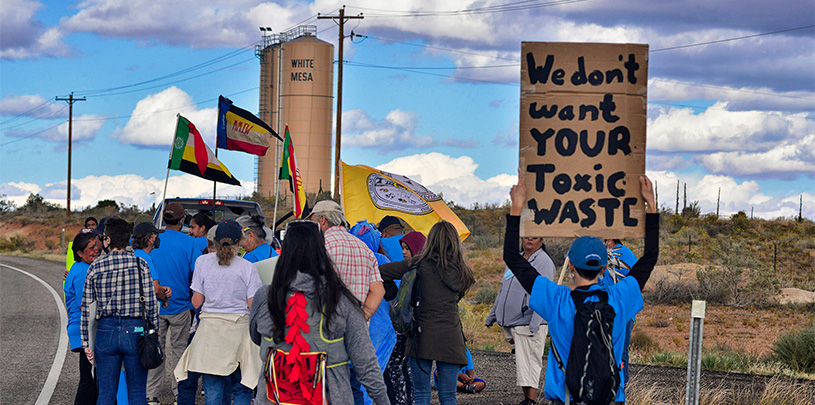
by Amber Reimondo, Energy Director
The 2022 Russian invasion of Ukraine, and the U.S. ban on imports of Russian oil, natural gas, and coal, have rekindled concerns about where the United States gets its uranium and sparked renewed opportunism on the part of companies with mining operations in the United States. How much uranium does the United States import from Russia and other countries and what’s at stake if mining ramps up in the U.S.?
In 2020, the most recent year for which numbers are available, civilian U.S. nuclear power plants purchased about 49 million pounds of uranium, the bulk of it from abroad, for an average price of $33 per pound.
About 16 percent came from Russia, 22 percent from Canada, another 22 percent from Kazakhstan, and 11 percent from Australia.
Uranium imports from Russia are tightly controlled. An agreement between the U.S. Department of Commerce and the Russian Federation's State Atomic Energy Corporation Rosatom (ROSATOM) limits uranium imports from Russia, capping them at 15 percent from 2028 to 2040.
Uranium is a common metal that is found in varying quantities in rocks across the globe. More than 20 countries mine uranium, which is more abundant than silver or gold. But a deposit of uranium has to meet certain specifications to be considered a mineable resource. According to the World Nuclear Association, Australia holds 20 percent of the world’s uranium resources, followed by Kazakhstan (15 percent), Canada (9 percent), and Russia (8 percent), while the U.S. holds only 1 percent.
Of identified uranium resources in the United States, most are located in the Western states, many of them on or near tribal lands.
Why do U.S. power plants import most of the uranium they buy? Because it’s cheaper. In 2020, Russian uranium averaged about $25 per pound, cheaper than Kazakh uranium ($33 per pound), Canadian uranium ($35 per pound), or Australian uranium ($39 per pound).
Compare this to the $40-50 per pound the uranium company that owns Canyon Mine, also known as the Pinyon Plain Mine, (a contested uranium mine near the Havasupai Tribe’s sacred site of Red Butte, on national forest land not far from Grand Canyon National Park), has stated it needs in order to start mining.
The U.S. uranium industry can’t compete with the quantity and quality of uranium deposits internationally. Many countries, including Canada and Australia, have large deposits of uranium that are generally higher grade and cheaper to mine than uranium found in the United States, especially in the area around the Grand Canyon.
Since they can’t compete fairly on the open market, uranium companies hoping to mine in the U.S. have been pushing for government help, most recently in the form of a strategic uranium reserve. Such a reserve would subsidize U.S. uranium producers at taxpayer expense and could provide an economic boost for uranium operations that threaten tribal communities.
 Havasupai tribal members protest Canyon Mine. ROGER CLARK
Havasupai tribal members protest Canyon Mine. ROGER CLARK
Many tribes across the Western U.S. have opposed uranium mining and milling on their lands, and on cultural landscapes that are important to them. In the Southwest, the uranium industry has left a devastating impact on the Navajo Nation, including more than 500 abandoned uranium mines that contaminate soil and water to this day. For decades, the Havasupai Tribe has opposed Canyon Mine on their ancestral lands and has urged the U.S. Department of Energy to exclude the mine from any federal uranium reserve program. Many tribes support a permanent ban on new uranium mines on federally managed lands around the Grand Canyon.
In southeastern Utah, a mile from Bears Ears National Monument, the only operating conventional uranium mill in the U.S. poses a threat to the Ute Mountain Ute Tribe’s White Mesa community. As proposed by the Department of Energy, the uranium reserve would specifically include uranium produced from alternate feed processing, one of the activities at the White Mesa Mill. In 2021, the Ute Mountain Ute Tribal Council passed a resolution against the creation of a uranium reserve and calling for the mill to close.
Surely none of America’s uranium demand should enable Russian atrocities in Ukraine, but neither should it enable the continuation of environmental injustices against Indigenous communities in the United States. The federal government should not subsidize domestic uranium production that puts Indigenous communities and cultures at risk of bearing even more of America’s uranium contamination burden.
A small victory in the legal case challenging Daneros uranium mine, near Bears Ears National Monument.
Read MoreGroundwater pumping at a uranium mine near the Grand Canyon will affect the canyon's springs, scientists says.
Read MoreA rally in Salt Lake City followed by a spiritual walk in White Mesa demonstrate the Ute community's determination to see uranium mill close.
Read More